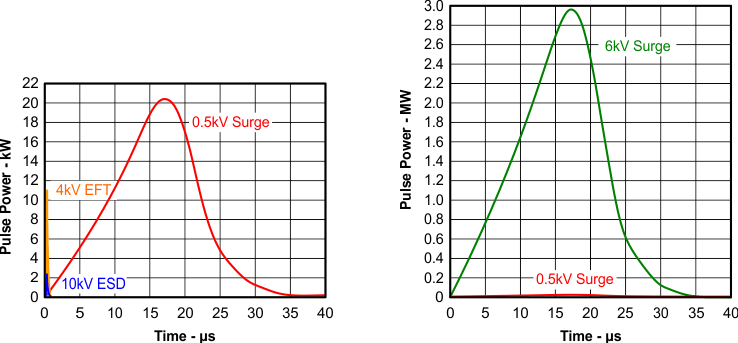SLLSF68 September 2019 THVD1505
PRODUCTION DATA.
- 1 Features
- 2 Applications
- 3 Description
- 4 Revision History
- 5 Pin Configuration and Functions
- 6 Specifications
- 7 Parameter Measurement Information
- 8 Detailed Description
- 9 Application and Implementation
- 10Power Supply Recommendations
- 11Layout
- 12Device and Documentation Support
- 13Mechanical, Packaging, and Orderable Information
Package Options
Mechanical Data (Package|Pins)
- D|8
Thermal pad, mechanical data (Package|Pins)
Orderable Information
9.1.6 Transient Protection
The bus terminals of the THVD1505 transceiver family possess on-chip ESD protection against ±16 kV HBM, ±8 kV IEC 61000-4-2 contact discharge and ±2 kV IEC 61000-4-4 EFT. The International Electrotechnical Commission (IEC) ESD test is far more severe than the HBM ESD test. The 50% higher charge capacitance, CS, and 78% lower discharge resistance, RD of the IEC model produce significantly higher discharge currents than the HBM model.
 Figure 25. HBM and IEC ESD Models and Currents in Comparison (HBM Values in Parenthesis)
Figure 25. HBM and IEC ESD Models and Currents in Comparison (HBM Values in Parenthesis) The on-chip implementation of IEC ESD and EFT protection significantly increases the robustness of equipment. Common discharge events occur because of human contact with connectors and cables. EFTs are generally caused by relay-contact bounce or the interruption of inductive loads.
Surge transients often result from lightning strikes (direct strike or an indirect strike which induce voltages and currents), or the switching of power systems, including load changes and short circuit switching. These transients are often encountered in industrial environments, such as factory automation and power-grid systems.
Figure 26 compares the pulse-power of the EFT and surge transients with the power caused by an IEC ESD transient. The left hand diagram shows the relative pulse-power for a 0.5-kV surge transient and 4-kV EFT transient, both of which dwarf the 10-kV ESD transient visible in the lower-left corner. 500-V surge transients are representative of events that may occur in factory environments in industrial and process automation. The right hand diagram shows the pulse-power of a 6-kV surge transient, relative to the same 0.5-kV surge transient. 6-kV surge transients are most likely to occur in power generation and power-grid systems.
Designers may choose to implement protection against longer duration surge transients. Figure 28 suggests two circuit designs providing protection against short and long duration surge transients. Table 3 lists the bill of materials for the external protection devices.
NOTE
The unit of the pulse-power changes from kW to MW, thus making the power of the 500-V surge transient almost dropping off the scale.
 Figure 26. Power Comparison of ESD, EFT, and Surge Transients
Figure 26. Power Comparison of ESD, EFT, and Surge Transients In the case of surge transients, high-energy content is signified by long pulse duration and slow decaying pulse power.
The electrical energy of a transient that is dumped into the internal protection cells of the transceiver is converted into thermal energy. This thermal energy heats the protection cells and literally destroys them, thus destroying the transceiver. Figure 27 shows the large differences in transient energies for single ESD, EFT, and surge transients as well as for an EFT pulse train, commonly applied during compliance testing.
 Figure 27. Comparison of Transient Energies
Figure 27. Comparison of Transient Energies Table 3. List of Components
| DEVICE | FUNCTION | ORDER NUMBER(1) | MANUFACTURER |
|---|---|---|---|
| XCVR | 5-V, 1-Mbps RS-485 Transceiver | THVD1505DR | TI |
| R1, R2 | 10-Ω, Pulse-Proof Thick-Film Resistor | CRCW0603010RJNEAHP | Vishay |
| TVS | Bidirectional 400-W Transient Voltage Suppressor | CDSOT23-SM712 | Bourns |
| TBU1, TBU2 | Bidirectional 200mA Transient Blocking Unit | TBU-CA-065-200-WH | Bourns |
| MOV1, MOV2 | 200-mA Transient Blocking Unit 200-V, Metal-Oxide Varistor | MOV-10D201K | Bourns |
 Figure 28. Transient Protections Against Surge Transients
Figure 28. Transient Protections Against Surge Transients The left circuit shown in Figure 28 provides surge protection of 1-kV transients, while the right protection circuits can withstand surge transients of 5 kV.